| 状态: | |
|---|---|
-
概述
Overview
导波雷达发出的高频微波脉冲沿着探测组件(钢缆或钢杆)传播,遇到被测介质,由于介电常数突变,引起反射,一部分脉冲能量被反射回来。发射脉冲与反射脉冲的时间间隔与被测介质的距离成正比。
The high-frequency microwave pulse sent by the guided wave radar propagates along the detection assembly (steel wire or steel rod), and meets the medium to be tested, which is reflected due to a sudden change in thedielectric constant, and part of the pulse energy is reflected. The time interval between the emitted and reflected impulses is positively proportional to the distance of the medium to be tested.

特 点Characteristics:
由于采用了先进的微处理器和独特的Echo Discovery回波处理技术,导波雷达物位计可以应用于各种复杂工况。
Thanks to the advanced microprocessor and the unique Echo Discovery - echo processing technology, the guided wave radar level meter can be applied to various complex operating conditions.
多种过程连接方式及探测组件的型式,使得70X系列导波雷达物位计适用于各种复杂工况及应用场合。如:高温、高压及小介电常数介质等。
A variety of process connections and types of detection components enable the 70X series guided wave radar level meters to be suitable for various complex operating conditions and applications. Such as high temperature, high voltage and small dielectric constant dielectrics.
采用脉冲工作方式,导波雷达物位计发射功率极低,可安装于各种金属、非金属容器内,对人体及环境均无伤害。
It adopts pulse operation, and the guided wave radar level meter has extremely low transmission power, can be installed in various metal and non-metal containers, and is harm-free to human and environment.
说 明
Description:
导波雷达是基于时间行程原理的测量仪表,雷达波以光速运行,运行时间可以通过电子部件被转换成物位信号。探头发出高频脉冲并沿缆式或杆式探头传播,当脉冲遇到物料表面时反射回来被仪表内的接收器接收,并将距离信号转化为物位信号。
The guided wave radar is a measurement instrument based on the principle of time trip. The radar wave operates at the speed of light, and the operation time can be transformed into a level signal through electronic components. The probes emit high-frequency impulses and travel along the cable-type or pole-type probes, which are reflected back and received by the receiver in the instrument when the impulses meet the surface of the material, and transform the distance signal into a level signal.
反射的脉冲信号沿缆式或杆式探头传导至仪表电子线路部分,微处理器对此信号进行处理,识别出微波脉冲在物料表面所产生的回波。正确的回波信号识别由脉冲软件完成,距离物料表面的距离D与脉冲的时间行程T成正比:
The reflected impulse signal is transmitted to the instrument electronic line part along the cable-type or pole-type probe, which is processed by the microprocessor to identify the echo generated by the microwave pulse on the surface of the material. Proper echo signal identification is done by the impulse software, with a distance D from the surface of the material and a time travel T of the impulse being positively regular:
D=C×T/2
其中C为光速
where C is the speed of light
因空罐的距离E已知,则物位L为:
L=E-D
The distance E of the empty can is known so the level L is L=E-D
通过输入空罐高度E(=零点),满罐
高度F(=满量程)及一些应用参数来
设定,应用参数将自动使仪表适应测
量环境,对应于4-20mA输出。
Set by entering empty can height E (= zero point), full can height F (= full scale) and some application parameters, the application parameters will automatically adapt the instrument to the measurement environment, corresponding to the output of 4-20 mA.
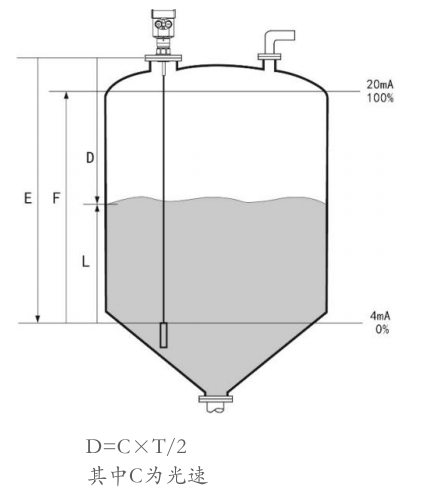
测量范围Measurement scope:
顶部盲区是指物料最高料面与测量参考点之间的最小距离。
The top blind zone refers to the minimum distance between the highest material surface of the material and the measured reference point.
底部盲区是指缆绳最底部附近无法精确测量的一段距离。
The blind zone at the bottom refers to a distance that cannot be accurately measured near the bottom of the cable.
顶部盲区和底部盲区之间是有效测量距离。
The distance is effectively measured between the top and bottom blind zones.

注意
Note:
只有物料处于顶部盲区和底部盲区之间时,才能保证罐内物位的可靠测量。
Reliable measurement of the position in the can only be ensured when the material is between the top blind zone and the bottom blind zone.
在整个量程范围内确定缆或杆不要接触到内部障碍物,因此安装时应尽可能避开罐内设施,如:人梯、限位开关、加热设备、支架等。另外需注意缆或杆不得与加料料流相交。
Be sure that the cable or pole should not come into contact with internal obstacles throughout the range, so avoid the facilities in the can as much as possible during installation, such as ladders, limit switches, heating equipment, bracket and so on. In addition, it should be noted that the cable or pole shall not intersect with the flow of added materials.
安装注意事项
Notes for installation:
l 最高料位不得进入测量盲区;仪表距离罐壁必须保持一定的距离;仪表的安装尽可能使缆或杆的方向与被测介质的表面垂直。安装在防爆区域内的仪表必须遵守国家防爆危险区的安装规定。本安型的外壳采用铝壳。本安型仪表可安装在有防爆要求的场合,仪表必须接大地。
Avoid the highest material level entering the blind zone of the measurement; the instrument must be kept at a certain distance from the can wall; the instrumentation shall be installed so that the direction of the cable or pole is vertical to the surface of the medium to be tested as much as possible. The instrumentation installed in the explosion-proof area must comply with the national installation regulations for the explosion-proof hazardous area. The shell of Exia is made of aluminum. Exia instruments can be installed in places where explosion prevention is required, and the instruments must be connected to the ground.

安装位置
Installation location:
Ø 尽量远离出料口和进料口。
Ø Keep it as far as possible from the outlet and inlet.
Ø 金属罐在整个量程范围内不碰罐壁及罐底。
Ø Avoid contacting with the wall and bottom of the metal can within the entire range.
Ø 建议安装在料仓直径的1/4或1/6处,与罐壁的最小距离为测量范围的1/10。
Ø It is recommended to be installed at 1/4 or 1/6 of the diameter of the bin, and the minimum distance from the can wall is 1/10 of the measured range.
Ø 缆式或杆式探头离罐壁最小距离≥300mm。
Ø The minimum distance between the cable or pole probe and the can wall is ≥ 300 mm,
Ø 探头底部距罐底≥30mm。
Ø The bottom of the probe is ≥ 30 mm from the bottom of the can.
Ø 探头距罐内障碍物最小距离≥200mm。
Ø The minimum distance between the probe and the obstacle in the can is ≥ 200 mm,
Ø 如果容器底部是锥型的,可以安装罐顶中央。
Ø The center of the top of the can be installed if the bottom of the container is conical.

杆式雷达物位计测量特点
Characteristics of pole radar level measurement:
Ø 可以测量介电常数≥1.8的任何介质。
Ø Any medium with a dielectric constant of ≥ 1.8 can be measured.
Ø 一般用于测量粘度≤500cst而且不容易产生粘附的介质。
Ø It is generally used for media with a viscosity of ≤ 500 CST and is not prone to adhesion.
Ø 杆式雷达最大量程可以达到6米,主要用于液体液位的测量。
Ø The maximum range of the pole radar can reach 6 meters, which is mainly used for the measurement of liquid level.
Ø 对蒸汽和泡沫有很强的穿透能力,测量不受影响。
Ø It has a strong penetration capability on steam and foam and is not influenced in the measurement.
Ø 泡沫较大的液体测量环境,应选择单杆式导波雷达物位计测量。
Ø For liquid measurement environments with large foams, a single bar guided wave radar level meter should be selected for measurement.
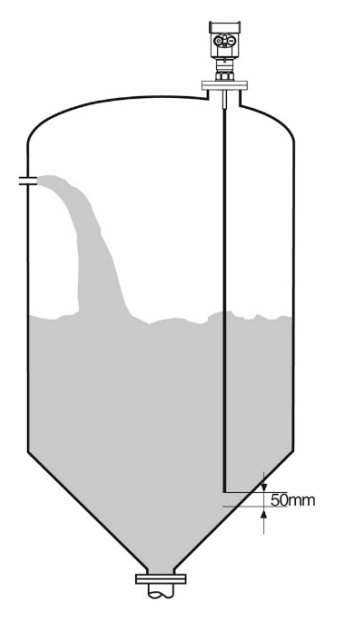
l 双缆式雷达物位计测量特点
Characteristics of Dual-Cable Radar Level Meter:
Ø 对于介电常数比较小的液体及轻质固体粉可以采用双缆式导波雷达物位计,以保障准确的测量效果。
Ø For liquids and light solid powders with small dielectric constants, a dual-wire guided wave radar level meter can be used to ensure accurate measurement.
Ø 可以测量介电常数≥1.6的任何介质。
Ø Any medium with a dielectric constant of ≥ 1.6 can be measured.
Ø 一般用于测量粘度≤500cst而且不容易产生粘附的介质。
Ø It is generally used for media with a viscosity of ≤ 500 CST and is not prone to adhesion.
Ø 双缆式雷达物位计最大量程可以达到30米。
Ø The maximum range of the dual-cable radar level meter can reach 30 meters.
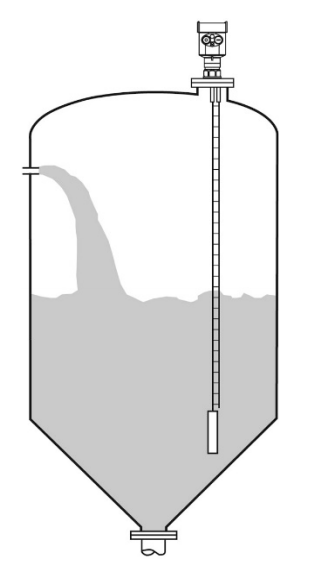
l 安装方法
Installation method
Ø 合理安装能确保仪表长期可靠而精确的测量
Reasonable installation ensures long-term reliable and accurate measurement of the instrument:
导波雷达物位计采用螺纹及法兰连接,可以在短管上进行安装。安装接管直径越小,接管长度应越短,测量越稳定。当安装短管直径在2″至6″则安装短管高度应≤200mm。若安装短管较长时,最好将短管截短,或将传感器屏蔽段部分做加长处理。
The guided wave radar level meter is connected by thread and flange and can be installed on the short pipe. The smaller the diameter of the installed junction pipe, the shorter its length is, the more stable the measurement will be. The height of the installation short pipe should be ≤ 200 mm when the diameter of the installation short pipe is from 2″ to 6″. If the short pipe is installed with a long one, it is best to shorten the short pipe or lengthen the shielding section of the sensor.

Ø DN200或DN250的短管内安装
Installation in short pipe of DN200 or DN250:
当导波雷达需要安装于直径大于200mm短管时,短管内壁产生回波,在介质介电常数低的情况下会引起测量误差。因此,对于一个直径为200mm或250mm的短管,需要选一个带“喇叭接口”的特殊法兰。
An echo will be generated on the inner wall of the short tube when the guided wave radar is required to be installed in the short tube with a diameter of more than 200 mm, which will cause measurement errors in the case of low dielectric constant. Therefore, for a short pipe with a diameter of 200 mm or 250 mm, a special flange with a "horn Antenna interface" is required.
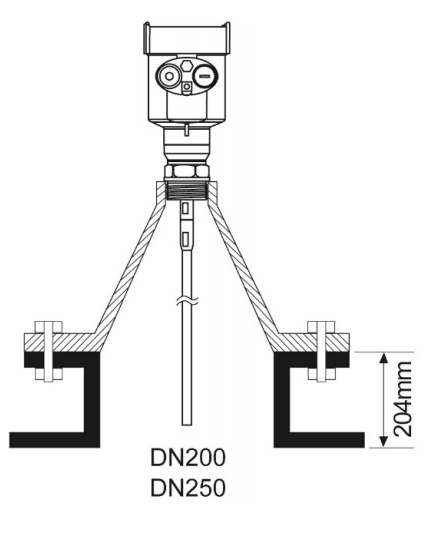
Ø 在塑料罐上的安装
Installation on a plastic can:
无论是缆式或杆式,若想导波雷达工作正常,过程连接表面一般为金属。当导波雷达装在塑料罐上时,若罐顶也是塑料或其它非导电材质时,仪表需要配金属法兰,若采用螺纹连接,需配一块金属板。
Whether it is in the form of a cable or pole, the process connection surface is generally metal if the guided wave radar is to work properly. When the wave guide radar is installed on the plastic can, the instrument needs to be equipped with a metal flange when the top of the can is also made of plastic or other non-conductive materials, and a metal plate if the threaded connection is used.
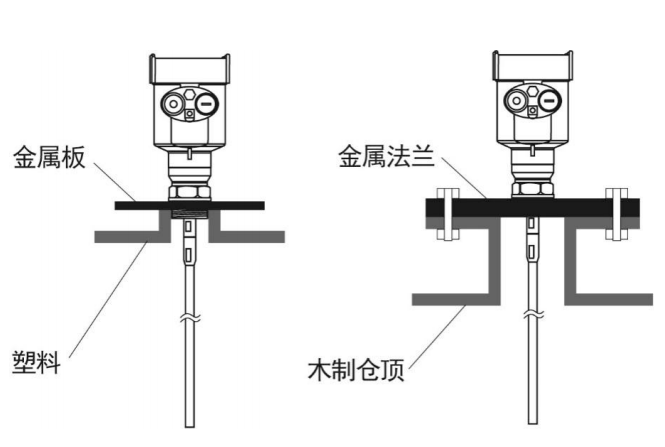
l 安装说明
Installation instructions
² 杆式探头最长可到6米,对于测量距离超过6米的储罐,可选用缆式探头。
² The length of the pole-type probe can be up to 6 meters, and for reservoirs with a measurement distance of more than 6 meters, a cable-type probe can be selected.
² 如果罐内障碍物比较多或过于靠近探头传感器时,可安装导波管进行测量。
² A waveguide can be installed for measurement in case the can is filled with obstacles or is too close to the probe sensor.
Ø 缆绳所受下拉力
Draw force on the rope
在加料和出料时,介质对缆绳探头产生下拉力,下拉力的大小取决于以下几个因素:
During feeding and discharging, the medium exerts a pulling force on the rope probe, the size of which depends on the following factors:
A.缆绳长度 B.物料的密度 C.储料仓的直径 D.缆绳的直径
A. Length of the rope B. Densities of the materials C. Diameter of the storage bin D. Diameter of the rope
Ø 干扰的优化
Optimization of interference
² 干扰回波抑制:编程调试软件可实现对干扰回波的抑制,从而达到理想测量效果。
² Interference echo suppression: Programming and debugging software can realize the suppression of interference echoes, thus achieving ideal measurement.
² 对于粘度不大于500cst的介质(仅适用于液体),可采用旁通管或导波管来避免干扰。
² For media with a viscosity of not more than 500 cst (only applicable to liquids), a by-pass or waveguide can be used to avoid interferences.
Ø Installation of low dielectric constant liquids
低介电常数液体的安装
对于介电常数大于1.3,粘度≤500cst且不易产生粘附的介质,可安装导波管进行测量,能达到以下效果:
For media with a dielectric constant greater than 1.3, a viscosity ≤ 500 cst and less adherence, a waveguide can be installed for measurement, which can achieve the following effects:
² 卓越的可靠性、高精度
² Excellent reliability and accuracy
² 可用于介电常数≥1.3的任何介质,测量与介质的导电性无关
² It can be used in any medium with a dielectric constant of ≥ 1.3, and the measurement is independent of the conductivity of the medium
² 罐内障碍物及短管尺寸不影响测量
² Obstacles in the can and the size of the short tube will not affect the measurement
Ø 腐蚀性介质测量
Corrosive medium measurement
如果测量腐蚀性介质,可选用杆式或缆式探头套PTFE、PFA套管进行测量
If measuring corrosive media, it is possible to use pole-type or cable-type probe sleeves PTFE and PFA sleeves for measurement
l 安装中的特别说明及注意事项:
Instructions and precautions in installation:
Ø 对于现场使用中缆绳过长的导波雷达,需要截取掉多余部分的缆绳,以保证正确的测量,不能将缆绳进行打结、缠绕或依附在于别的物体上。
Ø For the guided wave radar with over long cable in use on site, it is necessary to cut off the spare part of the cable to ensure proper measurement and not knot or wrap or attach the cable to other objects.
Ø 在截取缆绳时,首先要切断仪表电源,拆下缆绳,卸掉重锤上的螺丝,从缆绳最底部进行截取,裁切完成后需要重新装上重锤,待仪表安装完好后再接通电源并重新设置参数。
Ø When cutting off the cable, it is necessary to cut off the power supply of the instrument, remove the cable, remove the screw on the weight, and intercept from the bottom of the cable. After the cutting is finished, the weight should be reinstalled. After the installation, turn on the power supply and reset the parameters.
Ø 对于带套管的缆式导波雷达,在遇到缆绳过长时,不得自行截取,需返回原厂进行截取。
Ø For the cable guide wave radar with casing, it is forbidden to intercept itself when the Cable is too long and needs to return to the original factory for intercepting.
Ø 对于安装在导波管内的仪表,需采用绝缘支架固定雷达探头,保证雷达探头(杆/缆)与导波管同心,否则会因产生震荡或者虚假回波而影响测量。
Ø For instruments installed in the waveguide, the insulation bracket is required to fix the radar probe to ensure that the radar probe (rod/cable) is concentric with the waveguide, otherwise the measurement will be influenced by the generation of shock or false echoes.









